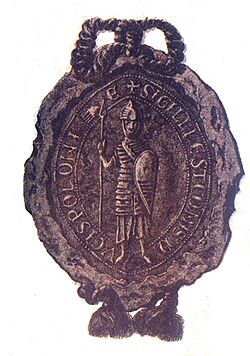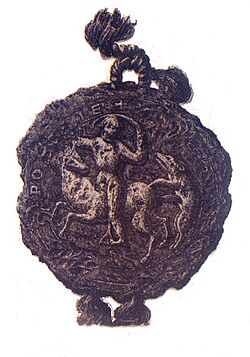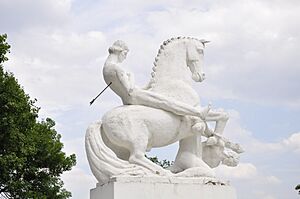Leszek the White facts for kids
Quick facts for kids Leszek the White |
|
|---|---|

Leszek the White, as imagined by Jan Matejko
|
|
| High Duke of Poland | |
| Reign | 1194–1198 1199 1206–1210 1211–1227 |
| Predecessor | Casimir II the Just |
| Successor | Władysław Spindleshanks |
| Duke of Sandomierz | |
| Reign | 1194–1227 |
| Predecessor | Casimir II the Just |
| Successor | Władysław Spindleshanks |
| Duke of Masovia | |
| Reign | 1194–1200 |
| Predecessor | Casimir the Just |
| Successor | Konrad I |
| Born | c. 1184/85 |
| Died | 24 November 1227 (age c. 42–43) Gąsawa, Kujawy, Poland |
| Spouse | Grzymisława |
| Issue | Salomea Bolesław the Chaste |
| House | House of Piast |
| Father | Casimir II the Just |
| Mother | Helen of Znojmo |
Leszek the White (Polish: Leszek Biały; born around 1184/85 – died 24 November 1227) was an important Polish ruler. He was the Prince of Sandomierz and the High Duke of Poland at different times between 1194 and 1227. The High Duke was like the main ruler of all the smaller Polish duchies. During his early years, his uncle, Duke Mieszko III the Old, and his cousin, Władysław III Spindleshanks, tried to take his place as High Duke.
Leszek was the oldest surviving son of Casimir II the Just and his wife Helen of Znojmo.
Contents
Becoming the High Duke of Poland
Early Challenges to Leszek's Rule
When Leszek's father, Casimir II, died in 1194, Leszek was only about nine or ten years old. His mother, Helen, became his regent, meaning she ruled for him until he was old enough. She had help from important leaders like Mikołaj Gryfita and Bishop Fulko of Kraków.
However, Leszek's uncle, Mieszko III the Old, wanted to be the ruler of Kraków again. He had been High Duke before but was removed. With help from powerful families, Mieszko decided to fight for control.
The Battle of Mozgawa and Its Aftermath
The war began in 1195. Leszek and his younger brother, Konrad, had support from the nobles of Kraków and Sandomierz, and from Prince Roman of Vladimir-in-Volhynia. Mieszko III also had allies, including his relatives from Silesia.
A very bloody battle happened on 13 September 1195, near Jędrzejów. Mieszko III's army fought Leszek's supporters. The battle was tough, and Mieszko III's son died. Mieszko III then left the battle. Leszek's side also had many injured, including Prince Roman. Later, more fighting happened when the Sandomierz army arrived and fought the Silesian forces. The Silesians won this part, but since Mieszko III had left, they also retreated.
Mieszko III's retreat allowed Leszek's regents to stay in power for three more years. But in 1198, Mieszko III finally took control of Kraków. Leszek's mother agreed to this in exchange for Leszek keeping his lands in Lesser Poland and Masovia, and also getting Kujavia. Mieszko III ruled Kraków until he died in 1202.
Around 1200, Leszek and Konrad became adults and started ruling their lands. Konrad received Masovia and Kuyavia, while Leszek kept Sandomierz. Leszek hoped to get Kraków back later.
After Mieszko III died, people wanted Leszek to rule Kraków again. But Leszek's ally, Mikołaj Gryfita, wanted Leszek to remove his trusted advisor, Goworek. Leszek refused to do this. So, Mikołaj Gryfita invited Mieszko III's son, Władysław III Spindleshanks, to be the new ruler of Kraków.
Władysław III ruled Kraków for some time. After Mikołaj Gryfita died in 1202, the nobles of Kraków invited Leszek to rule again without any conditions.
In 1207, Leszek made his lands part of the Pope's authority. This meant Poland was on the Pope's side, against the Holy Roman Emperor. Leszek then worked closely with Archbishop Henry Kietlicz to make changes suggested by the Pope.
Leszek's Actions in Kievan Rus'
Early Involvement and Shifting Alliances
In his early years, Leszek focused on events in Kievan Rus', a region to the east of Poland. In 1199, he helped Prince Roman of Vladimir-in-Volhynia regain his lands. This was likely a thank you for Roman's help in the Battle of Mozgawa.
However, this alliance ended in 1205 when Roman supported Władysław III Spindleshanks against Leszek. Roman then invaded Leszek's lands. Leszek and Konrad fought Roman at the Battle of Zawichost in 1205, where Roman was defeated and killed.
After Roman's death, Leszek and Konrad got involved in who would rule Roman's lands. King Andrew II of Hungary also got involved. Leszek and Konrad first tried to remove Roman's children from power. But to avoid a war with Hungary, they made a treaty. In 1206, Leszek met with Andrew II, and Hungary gained more influence over the region.
Despite this agreement, the conflict continued. Roman's widow and her younger son, Vasilko, were unhappy with Hungarian rule. They fled to Poland and found safety with Leszek.
Family Ties and Further Conflicts
Leszek and Konrad also made alliances through marriage with princesses from Kievan Rus'. Leszek first married a daughter of Prince Ingvar of Lutsk. Later, he married Grzymisława. Konrad married Agafia, daughter of Prince Svyatoslav III.
In 1210, King Andrew II of Hungary wanted Roman's oldest son, Daniel, to rule Vladimir-in-Volhynia. Leszek sent his troops there to keep his influence. But he had to call his army back because Mieszko Tanglefoot had taken Kraków.
Once Leszek got Kraków back, he returned to Kievan Rus' in 1212. He captured some border towns. In 1214, Leszek made a peace treaty with Andrew II of Hungary at Spiš. They agreed that Andrew II's son, Coloman, would rule Galicia–Volhynia and marry Leszek's daughter, Salomea. Leszek also gained some land in Kievan Rus'.
However, this alliance didn't last long. Leszek soon supported Daniel Romanovich in Galicia, as the local nobles didn't like Coloman's rule. In 1215, the Hungarians broke the alliance and attacked Leszek, making him lose the lands he had gained.
After this defeat, Leszek tried to ally with Prince Mstislav Mstislavich of Novgorod. But this led to Daniel Romanovich and Mstislav allying against Leszek. As a result, Leszek lost more land in 1218.
These failures made Leszek rethink his alliance with Andrew II of Hungary. They made a new treaty, and Coloman and Salomea officially married. Leszek gave up his claim to Galicia and received Volhynia instead.
In late 1219, Polish and Hungarian forces joined together. Coloman and Salomea were declared rulers of Galicia. Leszek also tried to take Vladimir-in-Volhynia, but he failed. Another attempt in 1221 also failed. These invasions led Daniel, who had made peace with Mstislav, to attack. Coloman and Salomea were captured, and Mstislav became Prince of Galicia.
In 1223, Mstislav and Andrew II made an unexpected alliance about Galicia. They agreed that after Mstislav's death, Galicia would go to Andrew II's youngest son, Andrew. This led to Leszek and Daniel allying against them. Mstislav attacked Leszek in 1225, but the war ended without a clear winner. In 1227, Leszek joined Hungary against Daniel. This was Leszek's last involvement in the long conflict in Kievan Rus'.
Leszek's Rule in Kraków
Challenges and Church Relations
Leszek's peaceful rule in Kraków was interrupted in 1210. Pope Innocent III issued a papal bull (a formal order from the Pope) that removed Leszek from power. Mieszko Tanglefoot used this chance to quickly take Kraków and become High Duke. The Pope's order was a surprise to Leszek and the local church leaders who supported him.
Archbishop Henryk Kietlicz called a meeting of Polish dukes at the Synod of Borzykowa. He wanted to solve this problem. Leszek, wanting the Church's support, gave special rights to the clergy. This protected the Church's land. Mieszko Tanglefoot was not at the meeting. He went to Kraków and took the capital without a fight. This was Mieszko's greatest success, but he died the next year. Leszek then returned to Kraków easily.
Another meeting between the dukes and the Church happened at the synod of Wolbórz. There, Archbishop Kietlicz gained more rights for the Church. Leszek's good relationship with the Archbishop ended in 1216 when the Archbishop lost favor with the new Pope.
Christianizing Prussia
Efforts to Convert and Protect Borders
Leszek also focused on Pomerania and converting the people of Prussia to Christianity. In 1212, Leszek and Konrad met with Mestwin I of Pomerelia to plan a Christian mission. This mission started four years later but didn't have much success.
The idea of Christianizing Prussia continued. Henry I the Bearded and Władysław III Spindleshanks also became interested. In 1217, Leszek and Henry I met, and a year later, Leszek, Henry I, and Władysław III formed an alliance. They signed a treaty that said Leszek would inherit Władysław III's lands if Władysław died without children. This agreement also meant Władysław III's nephew, Władysław Odonic, would not inherit. This alliance allowed Leszek to use the title dux Poloniae, meaning "Duke of Poland," from 1218.
Leszek, Henry I, Władysław III, Konrad I, and Swietopelk II of Pomerelia all wanted to convert the Prussians. But it soon became clear that Swietopelk's real goal was to make his own lands independent.
When Pope Innocent III asked Leszek to join a Crusade to the Holy Land, Leszek famously replied that Polish knights wouldn't go because there was "no wine, mead, or even beer to be had."
They first tried to convert the Prussians peacefully through trading centers. But when this didn't work, they decided on a military expedition in 1222. This failed, especially when Swietopelk II pulled out his support. Swietopelk also gave refuge to Władysław Odonic, who was fighting against his uncle Władysław III.
To deal with attacks from the Prussians, the Polish rulers created a "Knight Guard" to protect their borders. Knights from all their lands had to join. But this guard failed in 1224 after the Lesser Poland knights were surprised and defeated by the Prussians.
In 1225, some nobles conspired against Leszek and invited Henry I the Bearded to take the throne of Kraków. Henry I broke his alliance with Leszek and marched towards Kraków. But a different attack on his own lands forced Henry I to retreat. Before he left, his troops almost fought Leszek's forces, but they made an agreement instead. It was clear that their old alliance was broken.
New problems arose in 1227. Władysław III Spindleshanks was struggling with his nephew, Władysław Odonic. Leszek was interested because he still hoped to inherit Władysław III's lands. Władysław Odonic lost Swietopelk II's support, so both sides wanted to end the conflict. Leszek also wanted to deal with the independent actions of the Pomerelian Duke.
Leszek's Assassination
A meeting of Polish Dukes was held in November 1227, in the area of Gąsawa. Leszek, Władysław Odonic, Henry I the Bearded, and Konrad I of Masovia attended. Władysław III Spindleshanks, who was very interested, did not come. They likely discussed the actions of Świętopełk II of Pomerelia.
On the morning of 24 November, the princes were attacked while they were bathing. Henry I was badly hurt, but his knight, Peregrinus, saved him by shielding him with his own body. Leszek managed to escape on his horse to a nearby village, Marcinkowo. But the attackers caught up to him and killed him. Historians believe the attackers were men of either Władysław Odonic or Świętopełk II, or perhaps a group working for both. Leszek's body was taken to Kraków and buried in Wawel Cathedral by 6 December 1227.
Leszek the White's death changed Poland greatly. Even with his difficult rule, he was the Duke of Kraków recognized by all the Polish princes. After his death, Świętopełk II declared himself independent from Poland. Leszek's son, Bolesław V, was only one year old. So, control over Kraków was fought between Leszek's brother Konrad I and Władysław III Spindleshanks. Eventually, Duke Henry I the Bearded of Silesia became the High Duke in 1232.
Family Life
Leszek was married twice. First, in 1207 or 1208, to a daughter of Prince Ingvar whose name is not known. After this marriage ended, he married Grzymisława in 1210 or 1211. She might have been a daughter of Yaroslav IV Vladimirovich. Leszek and Grzymisława had two children:
- Salomea (born 1211/12 – died 17 November 1268): She married Prince Coloman, son of King Andrew II of Hungary, in 1215. They were meant to rule Galicia–Volhynia, but their plans didn't work out. After her husband died in 1241, she became a nun.
- Bolesław V the Chaste (born 21 June 1226 – died 7 December 1279): He became the ruler of Poland at Kraków in 1243.
Church Buildings
In 1216, Leszek founded the Church of Saint Wenceslaus in the city of Radom. His son, Bolesław V the Chaste, later supported this church. In 1440, it was made bigger and partly rebuilt in the Gothic style.
Legacy
Leszek the White is sometimes called Leszek I. His name is also sometimes spelled Leszko or Lesco.
An opera about him, called Leszek Biały, was written by Józef Elsner and performed in 1809.
Images for kids
-
Leszek the White, as imagined by Jan Matejko








